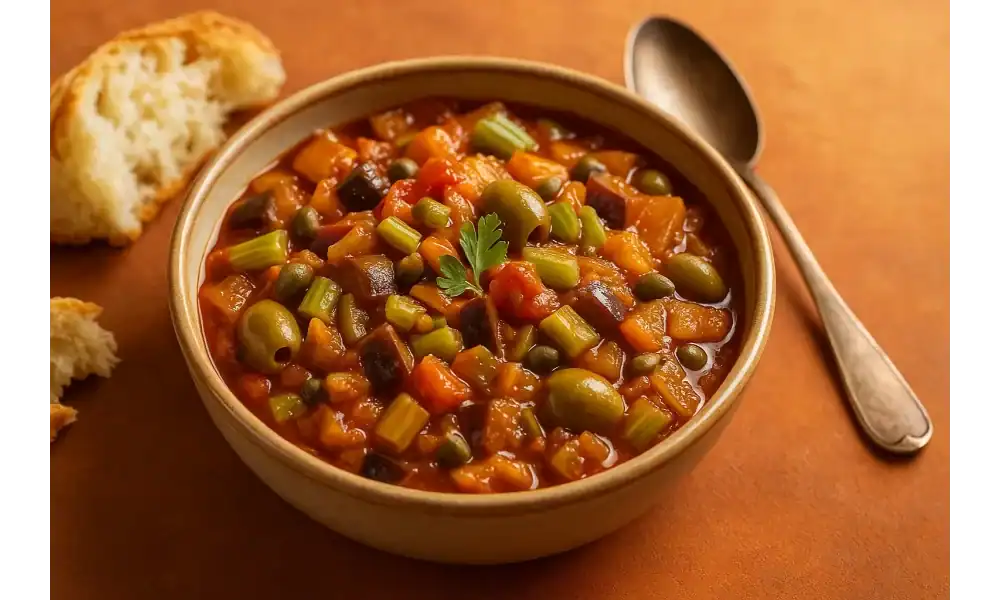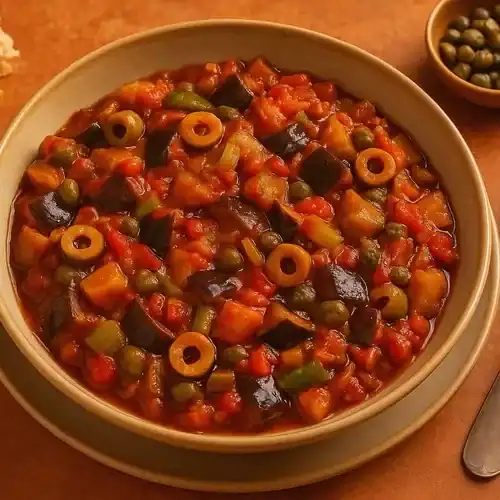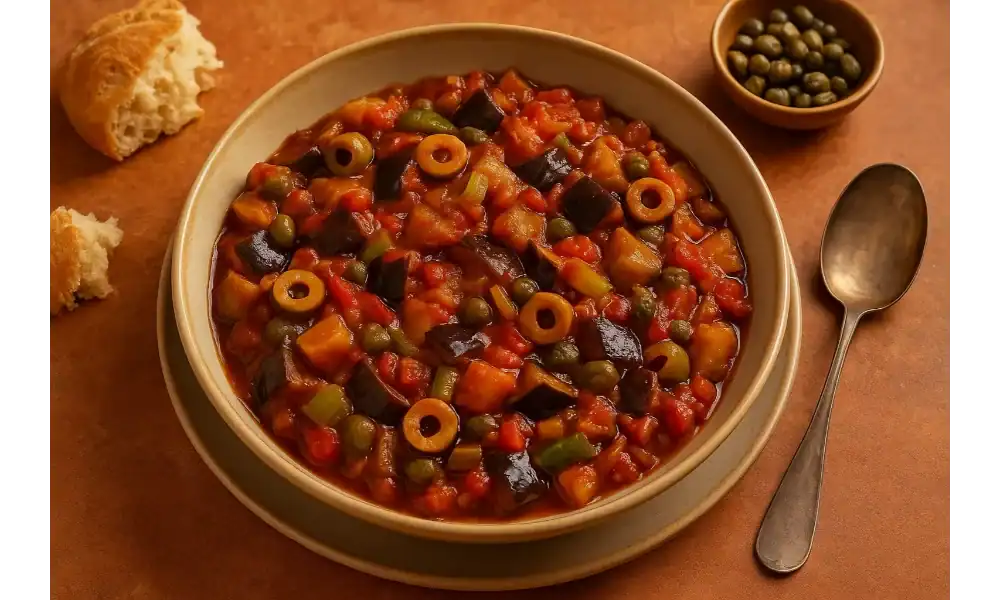Introduction
Caponata is a famous Sicilian eggplant dish that blends sweet and sour flavors in every bite. It brings together tender eggplant, fresh tomatoes, briny olives, and tangy capers. The mix of vinegar and a touch of sugar creates its unique taste. You can serve it as a starter with crusty bread, as a side for fish or meat, or even as a light main over pasta or rice. This traditional caponata recipe is naturally vegan and fits perfectly into a healthy Mediterranean diet. In this guide, you’ll learn how to prepare authentic Sicilian caponata at home with easy steps and simple ingredients.
If you are one of those eggplant lovers, you may also like:
- How to Make the Best Ratatouille – Authentic Provençal Vegetable Stew
- How to Make the Best Babaganoush at Home (Middle Eastern Eggplant Dip)
- How to Make Authentic Ratatouille Like a French Chef
- Top 15 Eggplant Recipes You’ll Want to Make Again and Again
- Best Ever Baked Eggplant Parmesan – Simple Step-by-Step Guide
What is Caponata? Origins and Culinary Tradition
History of Caponata – Roots in Sicilian Cuisine
Caponata is a classic dish from Sicily, dating back several centuries. It began as a humble fisherman’s meal, often served with bread instead of costly fish. Over time, it became a signature part of traditional Sicilian cuisine, blending the island’s love for vegetables and bold flavors.
Sicily’s Culinary Influence – Mediterranean Flavors
Sicilian cooking reflects the island’s rich history and diverse cultures. Greek, Arab, Spanish, and Italian influences shape its flavors. Mediterranean cuisine thrives here, using olive oil, fresh vegetables, herbs, and seafood. Caponata captures this mix in every bite.
Traditional Ingredients – Eggplant, Capers, Olives, Tomatoes
The heart of caponata is fresh eggplant, cooked until tender. Tomatoes add sweetness, while capers and green olives bring a salty bite. A splash of vinegar and a hint of sugar create the famous sweet-and-sour balance that makes caponata unique.
Variations Across Sicily – Regional Ingredient Twists
Different parts of Sicily add their own twist. Some recipes include raisins for extra sweetness, while others add peppers or pine nuts for texture. Coastal towns may serve it with fresh fish. Each version keeps the spirit of authentic Sicilian caponata alive.
Why It’s Popular Worldwide – Cultural and Culinary Appeal
Caponata has won hearts across the globe because it’s versatile, healthy, and full of flavor. It works as an appetizer, side, or main dish. Its vegan-friendly profile also fits modern diets, making it a Mediterranean eggplant dish loved in kitchens far from Sicily.
Ingredients for the Perfect Traditional Caponata

Main Ingredients – Eggplant, Onion, Celery, Tomatoes
The base of a traditional caponata recipe starts with fresh eggplant. Choose firm eggplants with smooth skin for the best texture. Onion and celery add depth and a gentle crunch. Ripe tomatoes bring natural sweetness and rich flavor to the dish. Together, they form the heart of this classic Sicilian eggplant dish.
Flavor Boosters – Capers, Green Olives, Pine Nuts (Optional)
Capers give a burst of tangy saltiness, while green olives add a bold, briny bite. Pine nuts, though optional, bring a delicate nuttiness that makes the flavor richer. These ingredients turn simple vegetables into a truly authentic Sicilian caponata.
Sweet and Sour Balance – Sugar and Vinegar
The soul of caponata lies in its sweet-and-sour balance. A small amount of sugar softens the acidity, while vinegar adds brightness. This mix is what gives caponata its unmistakable Mediterranean flavor profile.
Olive Oil Choice – Why Extra Virgin Works Best
Use extra virgin olive oil for cooking and finishing. It has a fuller flavor and enhances the taste of the vegetables. Good olive oil is essential for keeping the recipe true to Sicilian culinary traditions.
Optional Add-Ins – Peppers, Raisins, Herbs
You can make the dish your own by adding extras. Sweet peppers add color and a fresh crunch. Raisins offer a subtle sweetness. Fresh herbs like basil or parsley give the caponata a fragrant finish. These touches can make your homemade caponata even more memorable.
Step-by-Step Guide to Making Traditional Caponata
Preparing the Eggplant – Salting and Draining
Cut the eggplant into cubes. Sprinkle salt over them and place in a colander. Let them rest for 30 minutes to draw out bitterness and excess water. Rinse well and pat dry with a clean towel. This step keeps the traditional caponata recipe from becoming soggy.
Cooking the Vegetables – Onions, Celery, and Tomatoes
Heat extra virgin olive oil in a large pan. Sauté chopped onions and diced celery until soft. Add fresh or canned tomatoes and cook until they break down into a thick sauce. These vegetables form the base of authentic Sicilian caponata.
Adding Flavor Elements – Capers, Olives, Vinegar, Sugar
Stir in capers and sliced green olives for a salty bite. Add vinegar and sugar to create the signature sweet-and-sour flavor. Adjust amounts to balance the taste. This mix is what makes a Mediterranean eggplant dish stand out.
Combining and Simmering – Achieving the Perfect Texture
Add the prepared eggplant to the pan. Stir gently so the pieces stay intact. Let the mixture simmer until all flavors blend and the vegetables are tender. Keep the heat low to preserve the rich taste of the homemade caponata.
Cooling for Best Flavor – Why It Tastes Better the Next Day
Remove from heat and let it cool to room temperature. Store in the fridge for several hours or overnight. The rest time allows the flavors to deepen, making your Sicilian caponata even more delicious.
Serving Suggestions for Your Homemade Caponata

As an Appetizer – With Crusty Bread or Bruschetta
Serve your homemade caponata on warm, crusty bread or toasted bruschetta slices. The bread soaks up the rich sweet-and-sour juices, making every bite satisfying. This is a great way to start an Italian-inspired meal.
As a Side Dish – For Grilled Fish, Meat, or Chicken
Pair traditional Sicilian caponata with grilled fish, roasted chicken, or juicy steaks. Its tangy, savory flavors balance well with smoky, charred meats. This combination works for both casual dinners and special occasions.
As a Main – Served Over Pasta or Rice
Turn caponata into a light main course by serving it over pasta, rice, or even couscous. The Mediterranean eggplant dish blends beautifully with these bases, creating a filling but healthy meal.
For Tapas or Antipasto Platters – Party-Friendly Option
Add your authentic caponata to a tapas spread or antipasto platter. Combine it with cheese, cured meats, olives, and fresh bread. It’s colorful, flavorful, and perfect for sharing at parties.
Cold or Warm – When and Why to Choose Each
Enjoy caponata cold for a refreshing summer appetizer. Serve it warm during cooler months for comfort and depth of flavor. Both ways bring out the unique taste of this traditional caponata recipe.
Storage Tips and Make-Ahead Benefits
How to Store in the Fridge – Best Containers
Place your homemade caponata in an airtight glass or BPA-free plastic container. Glass works best because it keeps the flavors fresh and prevents staining. Store it in the coldest part of the fridge for maximum freshness.
Freezing Caponata – Yes or No?
You can freeze traditional Sicilian caponata, but the texture of the eggplant may change slightly. If you choose to freeze it, use freezer-safe containers or bags. Thaw in the fridge overnight before reheating.
Shelf Life – How Long It Stays Fresh
When stored in the fridge, authentic caponata stays fresh for up to five days. If frozen, it can last for up to three months without losing much flavor. Always check the aroma and texture before serving.
Flavor Enhancement Over Time – Benefits of Resting
Caponata tastes even better after a day or two in the fridge. The vegetables absorb more of the sweet-and-sour sauce, creating a richer Mediterranean eggplant dish. Resting time deepens the overall flavor.
Meal Prep Advantage – Quick Weekday Meals
Make a big batch and portion it into small containers. This makes homemade caponata perfect for quick lunches, easy dinners, or ready-to-serve appetizers. It’s a time-saver that keeps your meals healthy and flavorful all week.
Traditional Caponata Recipe

Traditional Caponata Recipe
Ingredients
Method
- Prep eggplant. Toss the diced eggplant with 1 Tbsp salt. Set in a colander for 30 minutes. Rinse and pat very dry.
- Brown eggplant. Heat 4 Tbsp oil in a wide pan over medium-high. Cook eggplant in 2–3 batches until golden and tender, 6–8 minutes total. Transfer to a plate.
- Soft-cook veg. Add remaining 2 Tbsp oil to the pan. Sauté onion and celery with a pinch of salt until soft, 5–6 minutes. Stir in garlic for 30 seconds.
- Make the sauce. Add tomatoes and tomato paste. Simmer until thick and saucy, 8–10 minutes.
- Add the sweet-sour. Stir in olives, capers, vinegar, sugar, and red pepper flakes. Simmer 2 minutes.
- Combine. Return eggplant to the pan. Stir gently. Simmer on low until glossy and jammy, 8–10 minutes. Season with salt, pepper, and more vinegar/sugar to balance.
- Rest and serve. Let it cool to warm or chill. Top with basil or parsley. Serve with crusty bread, grilled fish/meat, or over pasta/rice.
FAQs
1. What is caponata?
Caponata is a traditional Sicilian eggplant dish made with eggplant, tomatoes, celery, capers, and olives, all cooked in a sweet-and-sour sauce.
2. Is caponata served hot or cold?
You can serve authentic caponata warm or cold. Many prefer it cold, as the flavors deepen after resting.
3. Can I make caponata ahead of time?
Yes. Homemade caponata tastes even better the next day, making it perfect for meal prep and parties.
4. How do I store leftover caponata?
Store it in an airtight container in the fridge for up to five days. Use glass containers to keep the flavor fresh.
5. Is caponata vegan?
Yes. The traditional caponata recipe is naturally vegan and fits perfectly into the Mediterranean diet.
Conclusion
Making traditional Sicilian caponata is simple, yet the flavors feel rich and authentic. This recipe celebrates Sicily’s heritage with fresh vegetables, bold seasonings, and the perfect sweet-and-sour balance. It’s a dish you can serve as an appetizer, side, or main, making it a versatile choice for any table. Enjoy it at family gatherings, dinner parties, or as a quick weeknight meal. Try the recipe, then add your own twist to make it unique. Share your version in the comments so others can get inspired. For a complete Mediterranean experience, pair your homemade caponata with fresh salads, crusty bread, grilled seafood, or pasta. This is a recipe that brings people together, just as it has for generations in Sicily.
For more recipes, try our:
- The Best Chicago Pizza Recipe – Deep, Cheesy, and Full of Flavor
- How to Make the Best Philly Cheesesteak at Home (Authentic & Easy)
- How to Make Authentic Baja Fish Tacos – Crispy, Fresh, and Flavorful
- Homemade Chicken Pot Pie with Puff Pastry – So Easy, So Good!
- Quick and Easy Chicken Pot Pie with Creamy Filling (Step-by-Step)


2 thoughts on “How to Make Traditional Caponata at Home – Easy Italian Eggplant Dish”